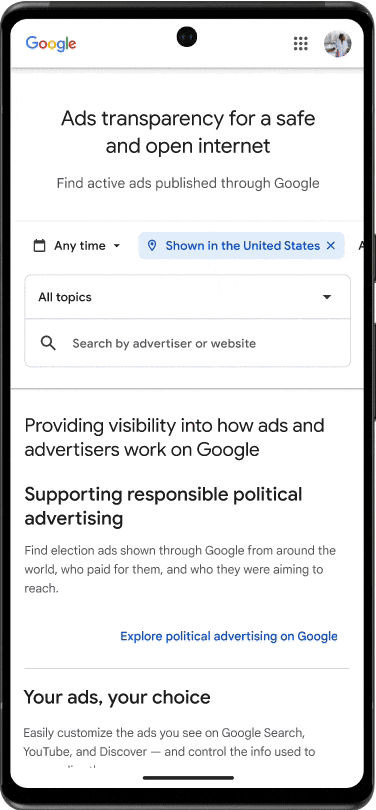Google introduces the new Ads Transparency Center to provide users with more information about the ads they see on Google channels such as search, YouTube, and the web.
Table of contents
Introduction of the Ads Transparency Center
Google has announced that the new Google Ads Transparency Center is being introduced worldwide. The aim is for users to learn more about the ads that are shown to them on various Google channels via Google Ads (SEM / SEA) be presented.
Insights into verified ads
In the Ads Transparency Center, users can view all ads that have been placed by verified advertisers. The aim is to give them quick access to information about the ads presented to them via Google. Among other things, the following details can be viewed:
- Which ads have already been placed by advertisers
- In which regions the ads were played
- The format of the ad and its last playout date
Users can also filter the listing specifically by region or display date to search for ads in a targeted manner.
Access to the Ads Transparency Center
The Ads Transparency Center can be accessed directly or via the "My Ads Center". Users can find the latter in the ads menu. Here they can see whether the advertisers are verified companies or not. In addition, they can endorse ads, block them, or report harmful ads if they violate the guidelines.
Customization of the personal ad experience
Google also enables further customization of the personal "ad experience" via the ad center. Here, users can specify their interests and thus influence the playout of ads.
Advertiser verification
Since 2018, political advertisers in the U.S. have had to verify themselves and indicate in the ads who is paying for the ad. Since 2020, this verification system has also existed in Germany, and outside of political advertising. For this purpose, the administrators of Google Ads accounts receive a notification and a request to fill out the "Information about the company" section. Here, details are requested about business activities and whether the company advertises itself or on behalf of others, for example, whether it is an agency.
Comparison with Facebook's advertising library
The announced ad center is similar to Facebook's ad library, which has existed since 2019. There, too, ads are cataloged and can be searched. There is also an API for faster access to the library. Users also have the option to download reports on specific advertisers. Ads are archived in the Facebook Ads Library for a period of seven years. How long ads are stored in the Google Ads Transparency Center has not been mentioned yet.
With the introduction of the Ads Transparency Center, Google is taking a step further in the direction of transparency and enabling users to better understand which ads are presented to them and why. The company is thus responding to the increasing desire for more control and transparency in the digital advertising market.
Advantages of the Ads Transparency Center
The Ads Transparency Center offers users several advantages:
1. information access to placed advertisements
With the Ads Transparency Center, users have the opportunity to view more detailed information about the ads that are played to them. They can see which ads were served by verified advertisers, in which regions they were played out, and what formats they have.
2. control over your own ad experience
Thanks to the Ads Center, users can customize their personal ad experience by specifying their interests and thus influence how ads are played. They can also block, endorse, or report ads if they violate the guidelines.
3. trust in verified advertisers
The Ads Transparency Center helps to strengthen trust in verified advertisers. By disclosing information about companies and their ads, users can better assess which advertisers are reputable and which are not.
Summary
With the Ads Transparency Center, Google aims to offer users more control and transparency in the digital advertising market. By disclosing information about ads and advertisers, the company strengthens trust in the digital advertising industry and enables users to make informed decisions about their ad settings and preferences. Given the growing concerns about privacy and trustworthiness of online advertising, it is an important step to better engage users and give them more control over their online experiences.





